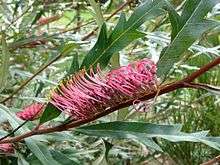Grevillea barklyana
| Gully Grevillea | |
|---|---|
 | |
| A hybrid of Grevillea barklyana | |
| Scientific classification | |
| Kingdom: | Plantae |
| (unranked): | Angiosperms |
| (unranked): | Eudicots |
| Order: | Proteales |
| Family: | Proteaceae |
| Genus: | Grevillea |
| Species: | G. barklyana |
| Binomial name | |
| Grevillea barklyana F.Muell. ex Benth. | |
Grevillea barklyana, also known as Gully Grevillea or Large-leaf Grevillea, is a tree which is endemic to an area near Labertouche, Victoria in Australia.
Description
Gully Grevillea grows up to 8 metres in height and flowers between October and December (mid spring to early summer) in its native range. These have whitish pink to fawn perianths and pale pink to pale crimson styles.[1] Leaves are between 5 and 27 cm long and 2.5 to 12 cm wide. These may be unlobed or have up to 7 or more lobes.[1]
Taxonomy
The species was first formally described by botanist Ferdinand von Mueller, his description published in Flora Australiensis in 1870.[2] Mueller had previously published the name in 1861, but without a formal description, in the Annual Report of the Government Botanist and Director of the Botanic and Zoologic Garden for 1860. The specific epithet honours Sir Henry Barkly who was Governor of Victoria between 1856 and 1863. In 1986 the New South Wales populations previously included in this species were placed in a new subspecies G. barklyana subsp. macleayana by botanist Donald McGillivray. This subspecies was raised to species status by Peter Olde and Neil Marriott in 1994 and named Grevillea macleayana.[2]
Distribution and habitat
Grevillea barklyana occurs in the upper catchments of the Bunyip and Tarago Rivers within the Bunyip State Park and adjoining State Forest.[3] It is found in gullies and on slopes, favouring a southerly aspect and clay-loam soils that are moist but well drained.[1][3] Associated tree species include Acacia dealbata, Eucalyptus obliqua, E. sieberi and E. regnans.[3] As plants do not store seed in their canopies and are not able to resprout, it is necessary for a soil seed reserve to be established to enable them to regenerate following bushfires.[3]
Conservation
The Labertouche Wildflower Reserve was created in 1963 to protect a significant population of Gully Grevillea as well as Forest Boronia (Boronia muelleri) and Grasstree (Xanthorrhoea australis). The reserve was included within the Bunyip State Park which was gazetted in 1992.[3] Approximately half of the known populations of the species occur within the boundaries of the park.[3]
The species is currently listed as "threatened" in Victoria under the Flora and Fauna Guarantee Act 1988 and "Vulnerable in Victoria" on the Department of Sustainability and Environment's Advisory List of Rare Or Threatened Plants In Victoria.[4][5]
Cultivation
Although Grevillea barklyana is regarded as a desirable plant for cultivation, it is not widely available in nurseries.[4] It is grown for its bird-attracting pink flowers, ornamental foliage and contrasting reddish new growth.The species can cope with heavy shade and has some frost tolerance.[6] As it has a weak root system, plants are best situated where they are afforded wind protection by other planting.[6] Propagation is by cuttings or seed.[3]
References
- 1 2 3 "Grevillea barklyana F.Muell. ex Benth.". Flora of Australia Online. Department of the Environment and Heritage, Australian Government.
- 1 2 "Grevillea barklyana". Australian Plant Name Index (APNI), IBIS database. Centre for Plant Biodiversity Research, Australian Government, Canberra. Retrieved 12 November 2012.
- 1 2 3 4 5 6 7 "Gully Grevillea" (PDF). Department of Sustainability and Environment. 2004. Retrieved 12 November 2012.
- 1 2 "Advisory List of Rare Or Threatened Plants In Victoria - 2005" (PDF). Department of Sustainability and Environment (Victoria). Retrieved 2012-01-15.
- ↑ "Threatened List July 2012" (PDF). Flora and Fauna Guarantee Act 1988. Department of Sustainability and Environment. Retrieved 12 November 2012.
- 1 2 Greig, D. (1987). The Australian Gardener's Wildflower Catalogue. Australia: Angus & Robertson. ISBN 0207154600.